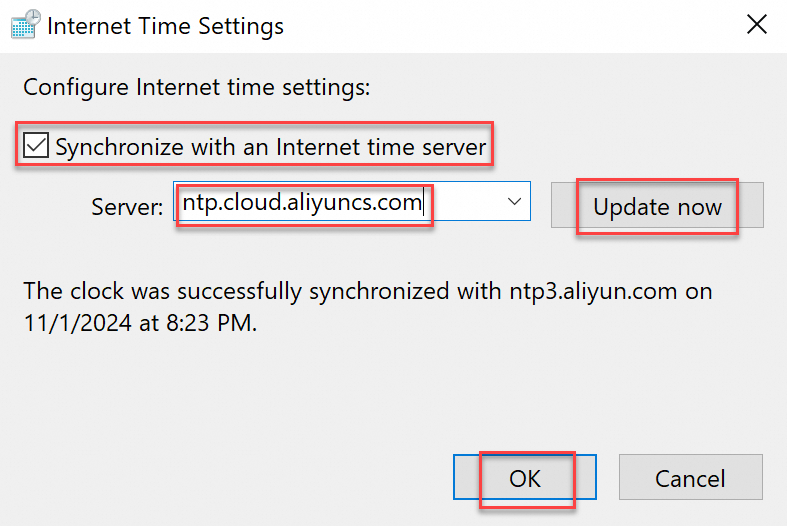Time drift can cause inconsistent scheduled tasks, mismatched log timestamps, and clock skew in distributed systems. To prevent these issues, configure a time synchronization service to automatically synchronize the time of your Elastic Compute Server (ECS) instance..
How it works

Network Time Protocol (NTP): A protocol for synchronizing time between a client and a server to within milliseconds by calculating network latency.
Alibaba Cloud NTP Server: A network of servers that provide time synchronization services. When accessed from within a virtual private cloud (VPC), they enable ECS instances to synchronize their time with extremely low network latency.
chrony/ntpd/W32time: Time synchronization clients that use the NTP protocol to synchronize an Instance's system time with an NTP server. On Linux and Unix-like systems, chrony is recommended for its higher accuracy and faster synchronization.
chronyoffers better performance thanntpd. Windows systems use the built-inW32timeservice.
Configure time synchronization
Linux (chrony)
Alibaba Cloud public images include a default time synchronization configuration. ECS Instances created from these images run chrony by default to synchronize their time.
Some older Public Images runntpdby default. Use theps -C chronyd,ntpd -o comm=command to check the running process. If the output isntpd, follow the steps in the Linux (ntpd) section to configure time synchronization.
1. Check and configure NTP server addresses
Edit the
chronyconfiguration file.Alibaba Cloud Linux/CentOS/RHEL
sudo vim /etc/chrony.confUbuntu/Debian
sudo vim /etc/chrony/chrony.confConfigure Alibaba Cloud NTP servers.
Comment out all existing
serverlines by prefixing them with a#. Then, add the following configuration to the file.Using multiple NTP servers provides redundancy and improves time accuracy by allowing the client to select the best server.
# Configuration information, including NTP server addresses, minimum polling interval, and maximum polling interval. server ntp.cloud.aliyuncs.com minpoll 4 maxpoll 10 iburst server ntp10.cloud.aliyuncs.com minpoll 4 maxpoll 10 iburst server ntp11.cloud.aliyuncs.com minpoll 4 maxpoll 10 iburst server ntp12.cloud.aliyuncs.com minpoll 4 maxpoll 10 iburst server ntp7.cloud.aliyuncs.com minpoll 4 maxpoll 10 iburst server ntp8.cloud.aliyuncs.com minpoll 4 maxpoll 10 iburst server ntp9.cloud.aliyuncs.com minpoll 4 maxpoll 10 iburstSave the configuration file, exit the editor, and restart
chrony.sudo systemctl restart chronyd.service
2. Verify time synchronization
After restarting, the service gradually adjusts the system time. Run sudo chronyc tracking to verify the synchronization status.
sudo chronyc trackingThe System time field in the output shows the offset between your system's clock and the NTP server's time. For example, 0.000036150 seconds fast of NTP time indicates a small discrepancy.
If the time offset is large (for example, several minutes or hours) and your workload can tolerate an abrupt time change, consider manually synchronizing the time.
Reference ID : 64643D58 (100.100.61.88) Stratum : 2 Ref time (UTC) : Sat Sep 20 07:55:33 2025 System time : 0.000036150 seconds fast of NTP time Last offset : +0.000031322 seconds RMS offset : 0.000044841 seconds Frequency : 43.592 ppm slow Residual freq : +0.000 ppm Skew : 0.005 ppm Root delay : 0.000228760 seconds Root dispersion : 0.010518964 seconds Update interval : 1029.1 seconds Leap status : NormalLinux (ntpd)
By default, some older Public Images for Alibaba Cloud ECS Instances, such as CentOS 6, come configured with the ntpd service. Because the NTP service is no longer actively maintained, we recommend upgrading to Chrony for better performance and security.
1. Check and configure NTP server addresses
Edit the
NTPconfiguration file.sudo vim /etc/ntp.confConfigure Alibaba Cloud NTP servers.
Comment out all existing
serverlines by prefixing them with a#. Then, add the following configuration to the file.Using multiple NTP servers provides redundancy and improves time accuracy by allowing the client to select the best server.
# Configuration information, including NTP server addresses, minimum polling interval, and maximum polling interval. server ntp10.cloud.aliyuncs.com iburst minpoll 4 maxpoll 10 server ntp11.cloud.aliyuncs.com iburst minpoll 4 maxpoll 10 server ntp12.cloud.aliyuncs.com iburst minpoll 4 maxpoll 10 server ntp7.cloud.aliyuncs.com iburst minpoll 4 maxpoll 10 server ntp8.cloud.aliyuncs.com iburst minpoll 4 maxpoll 10 server ntp9.cloud.aliyuncs.com iburst minpoll 4 maxpoll 10Save the configuration file, exit the editor, and restart
ntpd.Alibaba Cloud Linux/CentOS/RHEL
sudo service ntpd restartUbuntu/Debian
service ntp restart
2. Verify time synchronization
After restarting, the service gradually adjusts the time. You can run sudo ntpq -p to verify the status. The offset field in the output indicates the time difference between the local clock and the server. Key parameters include:
offset: The time offset between the system clock and the server, in milliseconds. A value closer to 0 indicates higher accuracy.jitter: The variation in time delay. A smaller value indicates more precise time synchronization.
If the time offset is large (for example, several minutes or hours) and your workload can tolerate an abrupt time change, consider manually synchronizing the time.
sudo ntpq -p remote refid st t when poll reach delay offset jitter ============================================================================== LOCAL(0) .LOCL. 10 l 17 64 1 0.000 0.000 0.000 +100.100.3.1 10.137.55.181 2 u 8 16 1 30.426 -307.76 0.153 *100.100.3.2 10.137.55.181 2 u 5 16 1 26.845 -309.25 0.221 +100.100.3.3 10.137.55.181 2 u 4 16 1 28.819 -309.37 0.187 -100.100.5.1 203.107.7.88 2 u 3 16 1 50.478 -310.70 0.164 -100.100.5.2 203.107.7.88 2 u 2 16 1 47.235 -311.89 0.246 100.100.5.3 203.107.7.88 2 u 1 16 1 53.661 -310.50 0.119Windows
Graphical user interface (GUI)
Change the default NTP server in Windows Server (time.windows.com) to an Alibaba Cloud NTP server. The following steps use Windows Server 2022 as an example.
In the notification area of the taskbar, click the date and time, and then click Date and time settings.

On the Settings page, click Related settings > Add clocks for different time zones.
In the Date and Time dialog box, click Internet Time > Change settings...
In the Internet Time Settings dialog box, select Synchronize with an Internet time server, enter
ntp.cloud.aliyuncs.com, click Update now, and then click OK.Verify the synchronization. A success message confirms that the time has been updated. If the synchronization fails, check if a firewall or security software is blocking UDP port 123.

Command-line interface (CLI)
1. Configure NTP servers
Change the default NTP server in Windows Server (time.windows.com) to an Alibaba Cloud NTP server. The following steps use Windows Server 2022 as an example.
Press
Win + R, entercmd, and then pressEnterto open the command prompt.Set the NTP server. The following example uses
ntp11.cloud.aliyuncs.com.w32tm /config /manualpeerlist:"ntp11.cloud.aliyuncs.com" /syncfromflags:manual /reliable:YES /updateRestart the time service.
net stop w32time net start w32timeSynchronize time with the NTP server.
w32tm /resync
2. Verify time synchronization
Run the w3tm /query /status command. If the Source is Local CMOS Clock instead of the configured NTP server address, the synchronization has failed.
w32tm /query /status
FAQ
How can I manually force a time synchronization?
To avoid the risks associated with sudden time jumps, we do not recommend manual synchronization. However, if the time offset is significant (for example, several minutes or hours) and your workload can tolerate a sudden time jump, you can manually synchronize the time.
Linux (chrony)
Stop
chrony.sudo systemctl stop chronyd.serviceManually synchronize the time.
sudo chronyd -qStart
chrony.sudo systemctl start chronyd.service
Linux (ntpd)
Alibaba Cloud Linux/CentOS/RHEL
Stop
ntpd.sudo service ntpd stopManually synchronize the time.
sudo service ntpdate startStart
ntpd.sudo service ntpd start
Ubuntu/Debian
Stop
ntpd.sudo service ntp stopManually synchronize the time.
sudo ntpdate ntp.cloud.aliyuncs.com ntp7.cloud.aliyuncs.com ntp10.cloud.aliyuncs.com ntp11.cloud.aliyuncs.com ntp12.cloud.aliyuncs.comStart
ntpd.sudo service ntp start
How do I ensure correct time synchronization across an ECS cluster?
By default, ECS Instances come pre-configured with the unified Alibaba Cloud NTP service and require no changes. When creating a custom NTP configuration for a cluster, we recommend using Cloud Assistant to apply changes in batches. This ensures consistency and avoids manual errors.
What are the Alibaba Cloud NTP server domain names?
The following table lists the Alibaba Cloud NTP server addresses for different networks (IPv4 only).
For Alibaba Cloud ECS Instances: Use the VPC internal network domains for lower network latency.
For non-Alibaba Cloud instances: Use the Internet domains.
VPC internal network | Public network |
ntp.cloud.aliyuncs.com ntp7.cloud.aliyuncs.com ntp8.cloud.aliyuncs.com ntp9.cloud.aliyuncs.com ntp10.cloud.aliyuncs.com ntp11.cloud.aliyuncs.com ntp12.cloud.aliyuncs.com | ntp.aliyun.com ntp1.aliyun.com ntp2.aliyun.com ntp3.aliyun.com ntp4.aliyun.com ntp5.aliyun.com ntp6.aliyun.com ntp7.aliyun.com |
Is the Alibaba Cloud NTP service free of charge?
Yes, the Alibaba Cloud NTP service is free. Public images are pre-configured for time synchronization, and instances created from them automatically use chrony or ntpd to keep their time accurate.
How do I upgrading from ntpd to chrony?
Some older Alibaba Cloud ECS images, such as CentOS 6, use ntpd. Since ntpd is no longer actively maintained, we recommend upgrading to chrony unless your workload has a specific dependency on ntpd.
Uninstall the
ntpservice.Alibaba Cloud Linux/CentOS/RHEL
sudo yum remove ntpUbuntu/Debian
sudo apt remove ntpInstall
Chrony.If the download fails, see How to fix yum failures when installing chrony on CentOS 6 (EOL)?
Alibaba Cloud Linux/CentOS/RHEL
sudo yum install chronyUbuntu/Debian
sudo apt update sudo apt install chronyConfigure
Chrony.Edit the configuration file.
Alibaba Cloud Linux/CentOS/RHEL
sudo vim /etc/chrony.confUbuntu/Debian
sudo vim /etc/chrony/chrony.confAdd NTP servers and other settings to the file. The following is a simple
chrony.confexample:# NTP server settings server ntp.cloud.aliyuncs.com minpoll 4 maxpoll 10 iburst # Specify the location of the drift file driftfile /var/lib/chrony/drift # Allow chronyd to be queried from localhost allow 127.0.0.1Parameter descriptions:
Parameter
Description
server <address>The domain name or IP address of the NTP server.
chronyconnects to this server to synchronize time.minpoll <n>The minimum polling interval, specified as a power of 2 in seconds.
minpoll 4means the minimum interval is 2⁴=16 seconds.maxpoll <n>The maximum polling interval, specified as a power of 2 in seconds.
maxpoll 10means the maximum interval is 2¹⁰=1024 seconds.iburstAn option that speeds up the initial synchronization. When
chronystarts, it sends a burst of requests to quickly achieve accurate time.Start the
chronyservice.Start the
Chronyservice and enable it to start on boot.# Start the chrony service sudo service chronyd start # Set chrony to start automatically when the system boots sudo chkconfig chronyd onCheck the
chronyservice status.# Check the service status sudo service chronyd statusVerify the time synchronization with the
chronyctool.sudo chronyc tracking
How to fix yum failures when installing chrony on CentOS 6 (EOL)?
Back up and remove the old
repoconfiguration files.sudo mkdir -p /etc/yum.repos.d/backup && sudo mv /etc/yum.repos.d/*.repo /etc/yum.repos.d/backup/Create a new repository configuration file that points to the official CentOS vault.
sudo tee /etc/yum.repos.d/CentOS-Vault.repo <<'EOF' [C6.10-base] name=CentOS-6.10 - Base baseurl=http://vault.centos.org/6.10/os/$basearch/ gpgcheck=1 gpgkey=file:///etc/pki/rpm-gpg/RPM-GPG-KEY-CentOS-6 enabled=1 [C6.10-updates] name=CentOS-6.10 - Updates baseurl=http://vault.centos.org/6.10/updates/$basearch/ gpgcheck=1 gpgkey=file:///etc/pki/rpm-gpg/RPM-GPG-KEY-CentOS-6 enabled=1 [C6.10-extras] name=CentOS-6.10 - Extras baseurl=http://vault.centos.org/6.10/extras/$basearch/ gpgcheck=1 gpgkey=file:///etc/pki/rpm-gpg/RPM-GPG-KEY-CentOS-6 enabled=1 EOFClean and rebuild the
yumcache.sudo yum clean all && sudo yum makecacheInstall
chrony.sudo yum install chrony
Related documents
To learn more about Linux time concepts and operations, or to understand changes to time configurations in Linux Public Images, see Linux time and time zones.